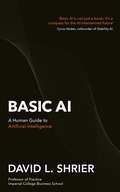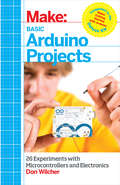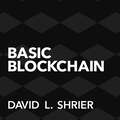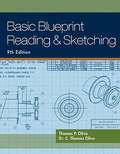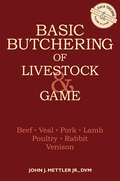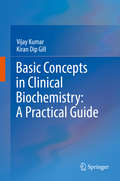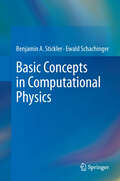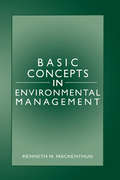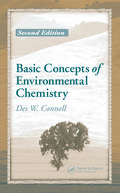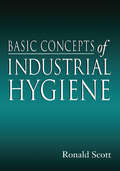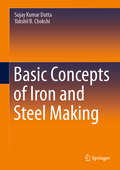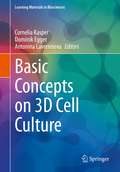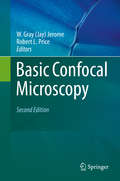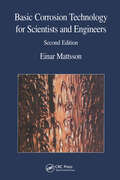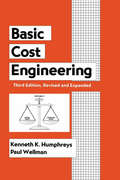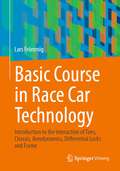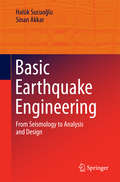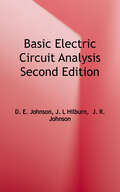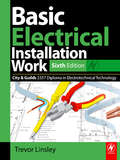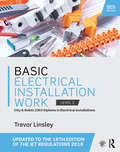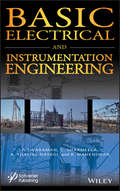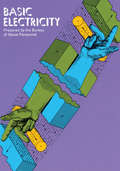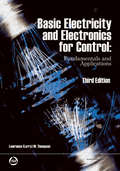- Table View
- List View
Basic AI: A Human Guide to Artificial Intelligence
by David ShrierIn Basic AI, leading futurist David L. Shrier delves deep into the rapidly advancing world of artificial intelligence, delivering fascinating insights and exploring the impact this powerful technology will have on our lives and world.Artificial intelligence is driving workforce disruption on a scale not seen since the Industrial Revolution. In schools and universities, AI technology has forced a re-evaluation of the way students are taught and assessed. Meanwhile ChatGPT has become a cultural phenomenon, reaching 100 million users and attracting a $10 billion dollar investment in its parent company OpenAI. The race to dominate the generative AI market is accelerating at breakneck speed, inspiring breathless headlines and immense public interest.Basic AI provides a rare window into a frontier area of computer science that will change everything about how you live and work. Read this book and better understand how to succeed in the AI-enabled future.
Basic Arduino Projects: 26 Experiments with Microcontrollers and Electronics
by Don WilcherThis companion book to MakerShed's Ultimate Arduino Microcontroller Pack provides 26 clearly explained projects that you can build with this top-selling kit right away--including multicolor flashing lights, timers, tools for testing circuits, sound effects, motor control, and sensor devices.With the Ultimate Arduino Microcontroller Pack, you'll find everything from common components such as resistors and capacitors to specialized sensors and actuators like force-sensing resistors and motors. The kit also features the Arduino Uno Microcontroller and a MakerShield, the definitive prototyping shield for Arduino.Build 26 cool mini Arduino projects and gadgetsWork on projects that are both instructive and have practical applicationGet circuit diagrams and detailed instructions for building each projectUnderstand circuit design and simulation with easy-to-use tools
Basic Blockchain: What It Is and How It Will Transform the Way We Work and Live
by David ShrierThe only book you need to understand blockchain: what it is, how it works and how it will transform business, society and our everyday lives. Basic Blockchain is an accessible, non-technical introduction to a revolutionary technology.'Makes it easy for the average business executive to understand blockchain' -- Chris Larsen, founder and chairman, Ripple'An essential tool for those looking to distinguish information from noise' -- Eva Kaili, MEP and Chair of The Committee for the Future of Science and TechnologyA revolution is under way across the globe, yet very few people understand it. Basic Blockchain will explain everything you need to know to understand the technology that will soon disrupt and revolutionise everything from financial and health services to the property market and how we vote.Born of an obscure body of research on game theory developed by NASA, originally championed by drug dealers seeking to launder ill-gotten gains, accelerated by entrepreneurs seeking to improve financial access for the poor, funded by giant corporate interests attracted to the potential for billions of dollars of cost savings, blockchain heralds a new era of financial inclusion, legal inclusion for the dispossessed and lower prices for consumers. In short, it will enact radical change on our lives.In this book, David L. Shrier, one of MIT and Oxford University's leading futurists, explains for the general reader:- The history of blockchain, its apocryphal progenitor Satoshi Nakamoto and the socioeconomic context of its origins in the 2008 financial crisis.- How blockchain works, including the core technologies that drive it such as cryptographic hashes and network theory, all described in simple, understandable terms.- The potential of blockchain, including its impact on our jobs, industry and society as a whole. Blockchain will disrupt and transform our world in profound ways. This accessible book, written by a global authority on blockchain, is the essential introduction to the next technological revolution.
Basic Blockchain: What It Is and How It Will Transform the Way We Work and Live
by David ShrierThe only book you need to understand blockchain: what it is, how it works and how it will transform business, society and our everyday lives. Basic Blockchain is an accessible, non-technical introduction to a revolutionary technology.'Makes it easy for the average business executive to understand blockchain' -- Chris Larsen, founder and chairman, Ripple'An essential tool for those looking to distinguish information from noise' -- Eva Kaili, MEP and Chair of The Committee for the Future of Science and TechnologyA revolution is under way across the globe, yet very few people understand it. Basic Blockchain will explain everything you need to know to understand the technology that will soon disrupt and revolutionise everything from financial and health services to the property market and how we vote.Born of an obscure body of research on game theory developed by NASA, originally championed by drug dealers seeking to launder ill-gotten gains, accelerated by entrepreneurs seeking to improve financial access for the poor, funded by giant corporate interests attracted to the potential for billions of dollars of cost savings, blockchain heralds a new era of financial inclusion, legal inclusion for the dispossessed and lower prices for consumers. In short, it will enact radical change on our lives.In this book, David L. Shrier, one of MIT and Oxford University's leading futurists, explains for the general reader:- The history of blockchain, its apocryphal progenitor Satoshi Nakamoto and the socioeconomic context of its origins in the 2008 financial crisis.- How blockchain works, including the core technologies that drive it such as cryptographic hashes and network theory, all described in simple, understandable terms.- The potential of blockchain, including its impact on our jobs, industry and society as a whole. Blockchain will disrupt and transform our world in profound ways. This accessible book, written by a global authority on blockchain, is the essential introduction to the next technological revolution.
Basic Blockchain: What It Is and How It Will Transform the Way We Work and Live
by David ShrierThe only book you need to understand blockchain: what it is, how it works and how it will transform business, society and our everyday lives. Basic Blockchain is an accessible, non-technical introduction to a revolutionary technology.'Makes it easy for the average business executive to understand blockchain' -- Chris Larsen, founder and chairman, Ripple'An essential tool for those looking to distinguish information from noise' -- Eva Kaili, MEP and Chair of The Committee for the Future of Science and TechnologyA revolution is under way across the globe, yet very few people understand it. Basic Blockchain will explain everything you need to know to understand the technology that will soon disrupt and revolutionise everything from financial and health services to the property market and how we vote.Born of an obscure body of research on game theory developed by NASA, originally championed by drug dealers seeking to launder ill-gotten gains, accelerated by entrepreneurs seeking to improve financial access for the poor, funded by giant corporate interests attracted to the potential for billions of dollars of cost savings, blockchain heralds a new era of financial inclusion, legal inclusion for the dispossessed and lower prices for consumers. In short, it will enact radical change on our lives.In this book, David L. Shrier, one of MIT and Oxford University's leading futurists, explains for the general reader:- The history of blockchain, its apocryphal progenitor Satoshi Nakamoto and the socioeconomic context of its origins in the 2008 financial crisis.- How blockchain works, including the core technologies that drive it such as cryptographic hashes and network theory, all described in simple, understandable terms.- The potential of blockchain, including its impact on our jobs, industry and society as a whole. Blockchain will disrupt and transform our world in profound ways. This accessible book, written by a global authority on blockchain, is the essential introduction to the next technological revolution.
Basic Blueprint Reading and Sketching
by Thomas P. Olivo C. Thomas OlivoFor over 50 years, Basic Blueprint Reading and Sketching has been an international best-seller, with close to $500,000 in sales and THE definitive resource for blueprint reading. The newly revised 9th edition of Basic Blueprint Reading and Sketching continues the traditions in helping to readers achieve competence in reading and sketching technical drawings. This classic interactive book/workbook will help users develop skills in reading and interpreting industrial drawings and preparing basic to advanced technical sketches. This book will provide them with basic principles, concepts, ANSI and SI Metric drafting symbols and standards, terminology, manufacturing process notes, and other related technical information contained on a mechanical or CAD drawing. Each unit features a basic principle and at least one blueprint and assignment that encourages students to practice newly learned skills. This edition contains coverage of the latest ANSI, ISO, AWS and ASME standards.
Basic Butchering of Livestock & Game: Beef, Veal, Pork, Lamb, Poultry, Rabbit, Venison
by John J. MettlerThis guide takes the mystery out of butchering, covering everything you need to know to produce your own expert cuts of beef, venison, pork, lamb, poultry, and small game. John J. Mettler Jr. provides easy-to-follow instructions that walk you through every step of the slaughtering and butchering process, as well as plenty of advice on everything from how to dress game in a field to salting, smoking, and curing techniques. You’ll soon be enjoying the satisfyingly superior flavors that come with butchering your own meat.
Basic Concepts in Clinical Biochemistry: A Practical Guide
by Vijay Kumar Kiran Dip GillThis book is a practical guidebook in biochemistry, for medical as well as life sciences' students. The book covers reference values, sample collection procedure and detailed protocol to perform experiments. Each experiment starts with a brief introduction of the protocol, followed by specimen requirements and procedure. The procedures are presented in a very lucid manner and discuss details of calculations and clinical interpretations,The book is divided into 29 chapters, It offers references, general guidelines and abbreviations and provides principles and procedures of clinical biochemistry tests, along with their diagnostic importance.
Basic Concepts in Computational Physics
by Ewald Schachinger Benjamin A. SticklerWith the development of ever more powerful computers a new branch of physics and engineering evolved over the last few decades: Computer Simulation or Computational Physics. It serves two main purposes:- Solution of complex mathematical problems such as, differential equations, minimization/optimization, or high-dimensional sums/integrals.- Direct simulation of physical processes, as for instance, molecular dynamics or Monte-Carlo simulation of physical/chemical/technical processes.Consequently, the book is divided into two main parts: Deterministic methods and stochastic methods. Based on concrete problems, the first part discusses numerical differentiation and integration, and the treatment of ordinary differential equations. This is augmented by notes on the numerics of partial differential equations. The second part discusses the generation of random numbers, summarizes the basics of stochastics which is then followed by the introduction of various Monte-Carlo (MC) methods. Specific emphasis is on MARKOV chain MC algorithms. All this is again augmented by numerous applications from physics. The final two chapters on Data Analysis and Stochastic Optimization share the two main topics as a common denominator. The book offers a number of appendices to provide the reader with more detailed information on various topics discussed in the main part. Nevertheless, the reader should be familiar with the most important concepts of statistics and probability theory albeit two appendices have been dedicated to provide a rudimentary discussion.
Basic Concepts in Environmental Management
by Kenneth M. MackenthunEnvironmental professionals are (and will continue to be) under increased pressure to become more knowledgeable of environmental management issues.Basic Concepts in Environmental Management fulfills the long-standing need for fundamental knowledge-especially concerning government regulations on environmental and natural resource protection.As a leading environmental professional and consultant since the 1940s, Kenneth M. Mackenthun offers a unique perspective on the breadth, scope, and ever-constant change in environmental legislation at the federal, state, and local levels... and what those guidelines signify for industry and citizens alike.By maintaining an awareness of existing and forthcoming laws, environmentalists can substantially enhance their career potential-and be in a better position to protect the land, air, and sea. The starting point for that knowledge: Basic Concepts in Environmental Management.
Basic Concepts of Environmental Chemistry
by Des W. ConnellBasic Concepts of Environmental Chemistry, Second Edition provides a theoretical basis for the behavior and biological effects of natural chemical entities and contaminants in natural systems, concluding with a practical focus on risk assessment and the environmental management of chemicals. The text uses molecular properties such as pola
Basic Concepts of Industrial Hygiene
by RonaldM. ScottBasic Concepts of Industrial Hygiene covers the latest and most important topics in industrial hygiene today. The textbook begins with a look at the history and basis for industrial hygiene, which provides students with a foundation for understanding later developments. The book contains an in-depth discussion of new OSHA regulations, such as HAZWOPER and Process Safety, which deal with high hazard situations. It also features a chapter on biological hazards of current concern in health care, including tuberculosis, AIDS, and hepatitis B.
Basic Concepts of Iron and Steel Making
by Sujay Kumar Dutta Yakshil B. ChokshiThis book presents the fundamentals of iron and steel making, including the physical chemistry, thermodynamics and key concepts, while also discussing associated problems and solutions. It guides the reader through the production process from start to finish, covers the raw materials, and addresses the types of processes and reactions involved in both conventional and alternative methods. Though primarily intended as a textbook for students of metallurgical engineering, the book will also prove a useful reference for professionals and researchers working in this area.
Basic Concepts on 3D Cell Culture (Learning Materials in Biosciences)
by Cornelia Kasper Antonina Lavrentieva Dominik EggerThis textbook shall introduce the students to 3D cell culture approaches and applications. An overview on existing techniques and equipment is provided and insight into various aspects and challenges that researchers need to consider and face during culture of 3D cells is given. The reader will learn the importance of physiological cell, tissue and organ models and gains important knowledge on 3D analytics. This textbook deepens selected aspects of the textbook “Cell Culture Technology”, which also is published in this series, while offering extended insight into 3D cell culture. The concept of the textbook encompasses various lectures ranging from basics in cell cultivation, tissue engineering, biomaterials and biocompatibility, in vitro test systems and regenerative medicine. The textbook addresses Master- and PhD students interested and/or working in the field of modern cell culture applications and will support the understanding of the essential strategies in 3D cell culture and waken awareness for the potentials and challenges of this application.
Basic Confocal Microscopy
by Robert L. Price W. Gray JeromeBasic Confocal Microscopy, Second Edition builds on the successful first edition by keeping the same format and reflecting relevant changes and recent developments in this still-burgeoning field. This format is based on the Confocal Microscopy Workshop that has been taught by several of the authors for nearly 20 years and remains a popular workshop for gaining basic skills in confocal microscopy. While much of the information concerning fluorescence and confocal microscopy that made the first edition a success has not changed in the six years since the book was first published, confocal imaging is an evolving field and recent advances in detector technology, operating software, tissue preparation and clearing, image analysis, and more have been updated to reflect this. Several of these advances are now considered routine in many laboratories, and others such as super resolution techniques built on confocal technology are becoming widely available.
Basic Corrosion Technology for Scientists and Engineers
by Einar MattssonAn introductory guide covering Basic Corrosion Technology for Scientists and Engineers first published in 1999.
Basic Cost Engineering
by Kenneth K. Humphreys Mike MüllerThis work focuses on the application of fundamental cost engineering principles to the capital and operating costs estimation of major projects. It provides detailed coverage of profitability, risk, and sensitivity analysis. This third edition: discusses novel strategies for calculating preliminary estimates using MasterFormat; presents new information on estimating the retrofitting and extension of existing plants; contains current international cost data; and more.;A solutions manual is available to instructors only.
Basic Course in Race Car Technology: Introduction to the Interaction of Tires, Chassis, Aerodynamics, Differential Locks and Frame
by Lars FrömmigThe focus of the book is on the driving dynamics of racing vehicles. The interaction of the tyre, the aerodynamics, of the chassis and the limited slip differential specific to racing vehicles is dealt with. A chapter on the basics of vehicle dynamics makes it possible to get started with this topic even without prior automotive engineering training. A historical review and a consideration of the essential safety aspects create an understanding of higher-level requirements, which are specified, for example, by the technical regulations.
Basic Earthquake Engineering: From Seismology to Analysis and Design
by Sinan Akkar Halûk SucuoğluThis book provides senior undergraduate students, master students and structural engineers who do not have a background in the field with core knowledge of structural earthquake engineering that will be invaluable in their professional lives. The basics of seismotectonics, including the causes, magnitude, and intensity of earthquakes, are first explained. Then the book introduces basic elements of seismic hazard analysis and presents the concept of a seismic hazard map for use in seismic design. Subsequent chapters cover key aspects of the response analysis of simple systems and building structures to earthquake ground motions, design spectrum, the adoption of seismic analysis procedures in seismic design codes, seismic design principles and seismic design of reinforced concrete structures. Helpful worked examples on seismic analysis of linear, nonlinear and base isolated buildings, earthquake-resistant design of frame and frame-shear wall systems are included, most of which can be solved using a hand calculator.
Basic Electric Circuit Analysis
by D. E. Johnson J. L Hilburn J. R. JohnsonKey equations are followed by a brief explanation to increase student comprehension of important mathematical concepts. Modern op amp is presented as a versatile linear circuit element. Highly motivational use of op amps with SPICE for exploratory active circuit design. SPICE tutorial material placed in clearly marked sections that can be skipped or de-emphasized. No reliance on SPICE or other computer methods in the remaining sections. Balanced emphasis given to the complementary time, phasor, and domain approaches which are the core of modern linear circuit analysis.
Basic Electrical Installation Work 2357 Edition, 6th ed
by Trevor LinsleyThis textbook covers all the material you need to pass the first part of the new City & Guilds 2357 Diploma in Electrotechnical Technology Aligned with the 17th edition IEE Wiring Regulations, this new edition has been thoroughly updated to cover the ‘knowledge’ section of the latest 2357 course. Written in an accessible style and with a separate chapter for each unit, this book helps you to master each topic before moving on to the next. End of chapter revision questions help you to check your understanding and consolidate the key concepts learned in each chapter. With associated online animations and instructional videos to further support your learning, this is the text that no electrical installations student should be without. Also available: Advanced Electrical Installation Work 6th editionTrevor LinsleyISBN: 9780080970424
Basic Electrical Installation Work: City And Guilds Edition
by Trevor LinsleyEverything needed to pass the first part of the City & Guilds 2365 Diploma in Electrical Installations. Basic Electrical Installation Work will be of value to students taking the first year course of an electrical installation apprenticeship, as well as lecturers teaching it. The book provides answers to all of the 2365 syllabus learning outcomes, and one chapter is dedicated to each of the five units in the City & Guilds course. This edition is brought up to date and in line with the 18th Edition of the IET Regulations: It can be used to support independent learning or a college based course of study Full-colour diagrams and photographs explain difficult concepts and clear definitions of technical terms make the book a quick and easy reference Extensive online material on the companion website www.routledge.com/cw/linsley helps both students and lecturers
Basic Electrical and Instrumentation Engineering
by P. Sivaraman C. Sharmeela A. Thaiyal Nayagi R. MahendranElectrical and instrumentation engineering is changing rapidly, and it is important for the veteran engineer in the field not only to have a valuable and reliable reference work which he or she can consult for basic concepts, but also to be up to date on any changes to basic equipment or processes that might have occurred in the field. Covering all of the basic concepts, from three-phase power supply and its various types of connection and conversion, to power equation and discussions of the protection of power system, to transformers, voltage regulation, and many other concepts, this volume is the one-stop, "go to" for all of the engineer's questions on basic electrical and instrumentation engineering. There are chapters covering the construction and working principle of the DC machine, all varieties of motors, fundamental concepts and operating principles of measuring, and instrumentation, both from a "high end" point of view and the point of view of developing countries, emphasizing low-cost methods. A valuable reference for engineers, scientists, chemists, and students, this volume is applicable to many different fields, across many different industries, at all levels. It is a must-have for any library.
Basic Electricity (Dover Books on Electrical Engineering)
by U.S. Bureau PersonnelThis expanded and revised U.S. Navy training course text provides thorough coverage of the basic theory of electricity and its applications. It is unquestionably the best book of its kind for either broad or more limited studies of electrical fundamentals.It is divided into 21 chapters and an extensive section of appendixes. Chapters cover safety, fundamental concepts of electricity, batteries, series direct-current circuits, network analysis of direct-current circuits, electrical conductors and wiring techniques, electromagnetism and magnetic circuits, introduction to alternating-current electricity, inductance, capacitance, inductive and capacitive reactance, fundamental alternating-current circuit theory, direct-current generators, direct current motor magnetic amplifiers, and synchros and servomechanisms. Appendixes acquaint lay readers with common terms, abbreviations, component color-code, full load currents of motors, and cable types; they also supply trig functions, square and square roots, basic formulas, and laws of exponents.Thus the reader is supplied with a complete basic coverage of all important aspects of electricity. And, drawing on its ample funds, the Navy was able to fill this text with dozens of illustrations so that the book becomes almost a multimedia teaching process.This is an excellent text for classroom use or for home study. Students will also find it a valuable supplement to courses in which theory is emphasized while little attention is paid to application; it will also supplement a course in which this situation is reversed. In addition, Basic Electricity serves the lay reader who simply wants a knowledge of fundamental concepts of electricity or wishes to study more advanced concepts and applications. 1969 edition.
Basic Electricity and Electronics for Control: Fundamentals and Applications
by Lawrence Larry M. ThompsonThis class-tested book gives you a familiarity with electricity and electronics as used in the modern world of measurement and control. Integral to the text are procedures performed to make safe and successful measurements of electrical quantities. It will give you a measurement vocabulary along with an understanding of digital and analog meters, bridges, power supplies, solid state circuitry, oscilloscopes, and analog to digital conversions. This book is about behavior, not design, and thus lends itself to an easy-to-understand format over absolute technical perfection. And where possible, applications are used to illustrate the topics being explained. The text uses a minimum of mathematics and where algebraic concepts are utilized there is sufficient explanation of the operation, so you may see the solution without actually performing the mathematical operations. This book is student centered. It has been developed from course materials successfully used by the author in both a college setting and when presented as short course study classes by ISA. These materials have been successful because of the insistence on practicality and solicitation of student suggestions for improvements. Basic Electricity and Electronics for Control will enhance student success in any industrial or technical school setting where basic technician training is to take place.
